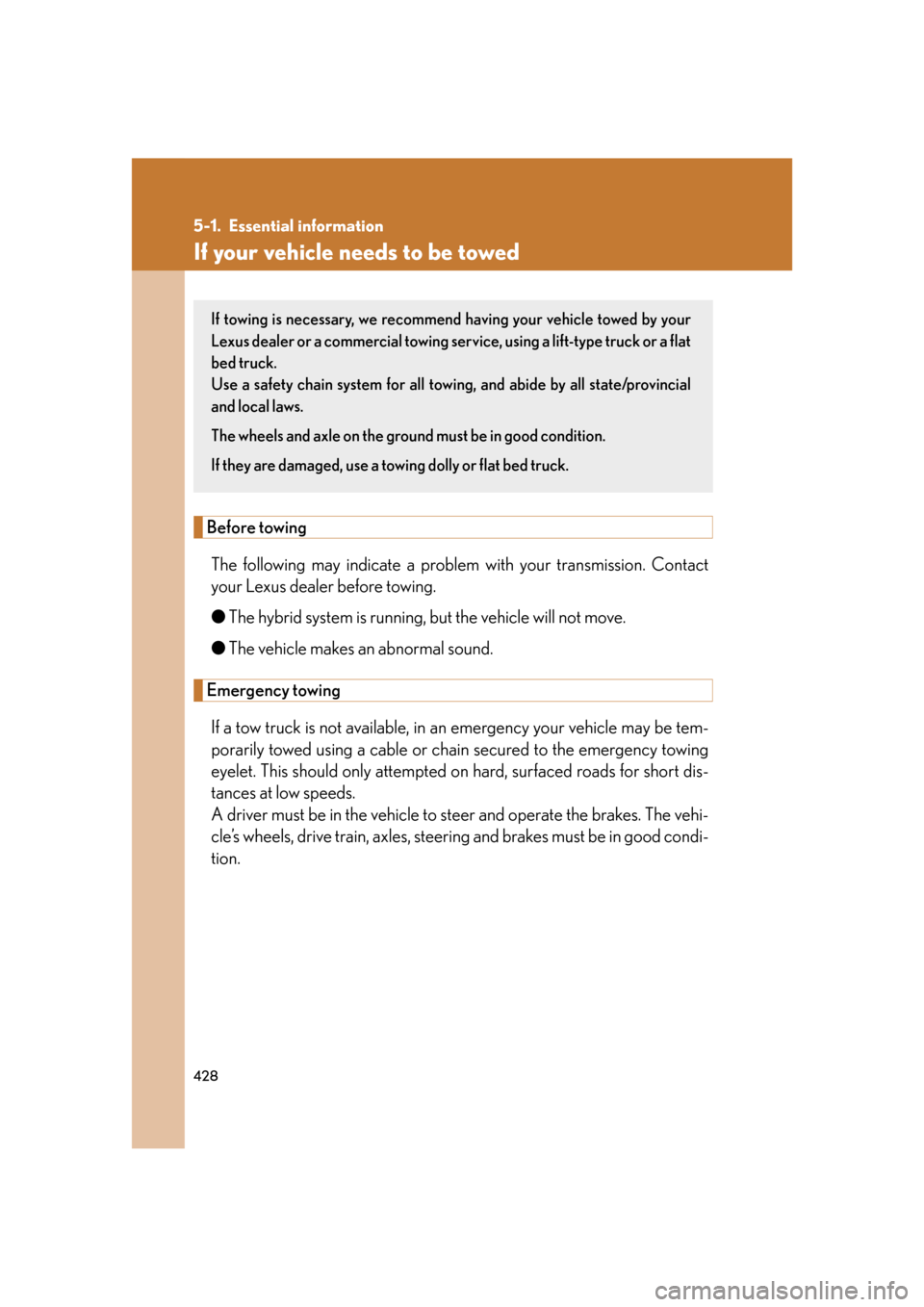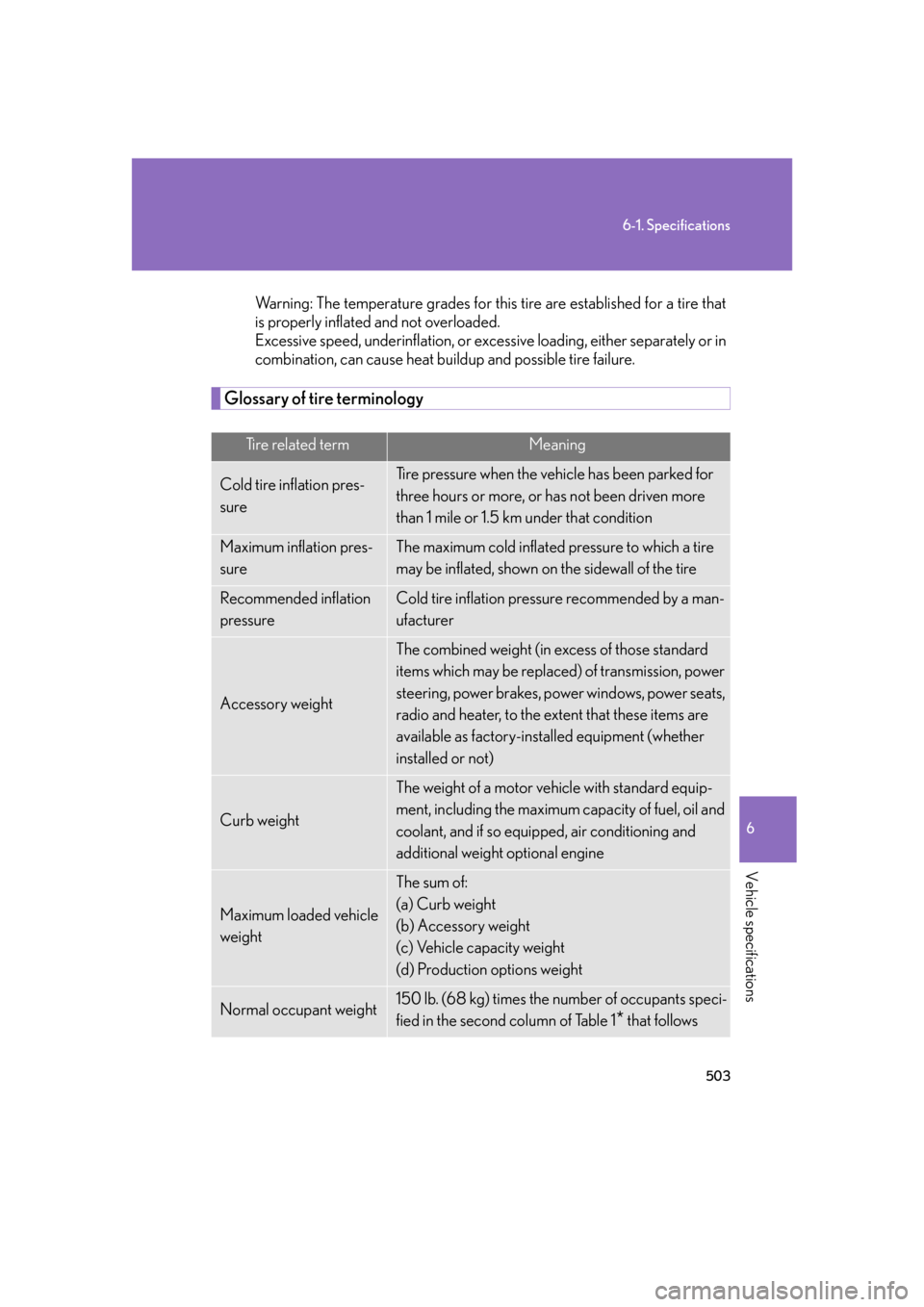brakes Lexus GS450h 2007 Using the audio system / LEXUS 2007 GS450H FROM JULY 2006 PROD. (OM30A05U) User Guide
[x] Cancel search | Manufacturer: LEXUS, Model Year: 2007, Model line: GS450h, Model: Lexus GS450h 2007Pages: 548, PDF Size: 16.31 MB
Page 448 of 548

428
5-1. Essential information
If your vehicle needs to be towed
Before towingThe following may indicate a problem with your transmission. Contact
your Lexus dealer before towing.
● The hybrid system is running, but the vehicle will not move.
● The vehicle makes an abnormal sound.
Emergency towing
If a tow truck is not available, in an emergency your vehicle may be tem-
porarily towed using a cable or ch ain secured to the emergency towing
eyelet. This should only attempted on hard, surfaced roads for short dis-
tances at low speeds.
A driver must be in the vehicle to s teer and operate the brakes. The vehi-
cle’s wheels, drive train, axles, steering and brakes must be in good condi-
tion.
If towing is necessary, we recommen d having your vehicle towed by your
Lexus dealer or a commercial towing service, using a lift-type truck or a flat
bed truck.
Use a safety chain system for all towing , and abide by all state/provincial
and local laws.
The wheels and axle on the ground must be in good condition.
If they are damaged, use a to wing dolly or flat bed truck.
Page 449 of 548

5
When trouble arises
429
5-1. Essential information
Towing eyelet
■Emergency towing procedureRelease the parking brake.
Put the shift lever in “N”.
The power switch must be in the “ACC” mode (hybrid system off) or the
“IG-ON” mode (hybrid system on).
CAUTION
■Caution while towing
●Use extreme caution when towing the vehicle.
Avoid sudden starts or erratic driving maneuvers which place excessive stress on
the emergency towing eyelet and the cable or chain.
●If the hybrid system is not running, the power assist for the brakes and steering
will not function, making steeri ng and braking more difficult.
NOTICE
■To prevent causing serious damage to the transmission
Never tow this vehicle from the front with the rear wheels on the ground.
This may cause serious dama ge to the transmission.
STEP1
STEP2
STEP3
Page 463 of 548

5
When trouble arises
443
5-2. Steps to take in an emergency
CAUTION
■If the tire pressure warning light comes on
Be sure to observe the following precautions. Failure to do so could cause loss of
vehicle control and result in death or serious injury.
●Vehicles with run-flat tires:
• Decelerate to the lowest appropriate speed as soon as possible. Do not drive
over 55 mph (90 km/h).
• Check and adjust the tire inflation pressure immediately.
• If the tire pressure warning light comes on even after tire inflation pressure
adjustment, it is probable that you have a flat tire. Have the tire replaced by
the nearest Lexus dealer.
• Avoid abrupt maneuvering and braking. If the vehicle tires deteriorate, you
could lose control of the steering wheel or the brakes.
●Vehicles with standard tires:
• Stop your vehicle in a safe place as soon as possible. Adjust the tire inflation pressure immediately.
• If the tire pressure warning light comes on even after tire inflation pressure adjustment, it is probable that you have a flat tire. Check the tires. If the tire is
flat, change to the spare tire and have the flat tire repaired by the nearest
Lexus dealer.
• Avoid abrupt maneuvering and braking. If the vehicle tires deteriorate, you
could lose control of the steering wheel or the brakes.
■If a blowout or sudden air leakage should occur
The tire pressure warning system may not activate immediately.
Page 473 of 548

5
When trouble arises
453
5-2. Steps to take in an emergency
Wa r n i n g m e s s a g eDetailsCorrection procedure
(Flashing)
(If equipped)
The radar cruise control
system is unable to judge
vehicle-to-vehicle dis-
tance.
• Switch the mode select to either the normal or
power mode.
• If the windshield wipers
are on, turn them off or
set them to either the
intermittent or the slow
mode.
(Flashing)
(If equipped)
Yo u r v e h i c l e i s n e a r i n g
the vehicle ahead (in
radar cruise mode).Slow the vehicle by apply-
ing the brakes.
The vehicle is unable to
drive over 60 mph (or
120 km/h) until the trans-
mission warms up.
Wait until the transmission
warms up.
(Flashing)
The hybrid battery (trac-
tion battery) is low.Stop the vehicle and shift
the shift lever to “P”.
(Flashing)
The gasoline engine can-
not operate or the shift
lever is in “N” for a long
time.
Stop the vehicle and shift
the shift lever to “P”.
Page 479 of 548

5
When trouble arises
459
5-2. Steps to take in an emergency
InteriorbuzzerExterior buzzerWa r n i n g m e s s a g eDetailsCorrection
procedure
An open door has
been closed and
the power switch
has been turned
twice to the
“A C C ” m o d e f r o m
“OFF” mode.
Press the
power
switch while
applying the
brakes.
(Flashing)
The steering lock
has not released
within 3 seconds
of pressing the
power switch. The
power switch indi-
cator will flash
green for 15 sec-
onds.Press the
power
switch again
while turn-
ing the
steering
wheel with
the brake
pedal
depressed.
Page 495 of 548

5
When trouble arises
475
5-2. Steps to take in an emergency
Starting the hybrid systemPut the shift lever in “P” and apply the brakes. Hold the electronic key close to
the power switch (within 0.4 in. [10
mm]). Make sure that the button
side of the key is facing away from
the power switch.
An alarm will sound to indicate that
the start function cannot detect the
key with the depleted battery if any
of the doors will be opened and
closed while this operation.
Press the power switch within 5 seconds after the buzzer sounds,
keeping the brake pedal depressed.
If the hybrid system still cannot be started, contact your Lexus dealer.
STEP1
STEP2
■Replacing the key battery
As this procedure is the temporary measure, it is recommended that the electronic
key battery be replaced immediately. ( P. 4 0 1 )
STEP3
Page 512 of 548

492
6-1. Specifications
Brakes
*1: Minimum pedal clearance when depressed with a force of 200 N (20.4 kgf, 45 lbf) while the hybrid system is running.
*2: Parking brake pedal travel when depressed with a force of 300 N (30.6 kgf, 67.4 lbf).
Steering
Pe d a l c l e a r a n c e *12.9 in. (73 mm) Min.
Pedal free playLess than 0.08 in. (2.0 mm)
Brake pad wear limit0.04 in. (1.0 mm)
Parking brake pedal travel *27 9 clicks
Parking brake lining wear limit0.04 in. (1.0 mm)
Fluid typeSAE J1703 or FMVSS No. 116 DOT 3
Free playLess than 1.2 in. (30 mm)
Page 523 of 548

503
6-1. Specifications
6
Vehicle specifications
Warning: The temperature grades for this tire are established for a tire that
is properly inflated and not overloaded.
Excessive speed, underinflation, or excess ive loading, either separately or in
combination, can cause heat build up and possible tire failure.
Glossary of tire terminology
Tire related termMeaning
Cold tire inflation pres-
sureTire pressure when the vehicle has been parked for
three hours or more, or has not been driven more
than 1 mile or 1.5 km under that condition
Maximum inflation pres-
sureThe maximum cold inflated pressure to which a tire
may be inflated, shown on the sidewall of the tire
Recommended inflation
pressureCold tire inflation pressure recommended by a man-
ufacturer
Accessory weight
The combined weight (in excess of those standard
items which may be replaced) of transmission, power
steering, power brakes, power windows, power seats,
radio and heater, to the extent that these items are
available as factory-installed equipment (whether
installed or not)
Curb weight
The weight of a motor vehicle with standard equip-
ment, including the maximum capacity of fuel, oil and
coolant, and if so equipped, air conditioning and
additional weight optional engine
Maximum loaded vehicle
weight
The sum of:
(a) Curb weight
(b) Accessory weight
(c) Vehicle capacity weight
(d) Production options weight
Normal occupant weight150 lb. (68 kg) times the number of occupants speci-
fied in the second column of Table 1
* that follows
Page 524 of 548

504
6-1. Specifications
Tire related termMeaning
Occupant distributionDistribution of occupants in a vehicle as specified in
the third column of Table 1
* below
Production options
weight
The combined weight of installed regular production
options weighing over 5 lb. (2.3 kg) in excess of the
standard items which they replace, not previously
considered in curb weight or accessory weight,
including heavy duty brakes, ride levelers, roof rack,
heavy duty battery, and special trim
RimA metal support for a tire or a tire and tube assembly
upon which the tire beads are seated
Rim diameter
(Wheel diameter)Nominal diameter of the bead seat
Rim size designationRim diameter and width
Rim type designationThe industry manufacturer's designation for a rim by
style or code
Rim widthNominal distance between rim flanges
Vehicle capacity weight
(Total load capacity)The rated cargo and luggage load plus 150 lb. (68
kg) times the vehicle's designated seating capacity
Vehicle maximum load on
the tireThe load on an individual tire that is determined by
distributing to each axle its share of the maximum
loaded vehicle weight, and dividing by two
Vehicle normal load on
the tire
The load on an individual tire that is determined by
distributing to each axle its share of curb weight,
accessory weight, and normal occupant weight (dis-
tributed in accordance with Table 1
* below), and
dividing it by two